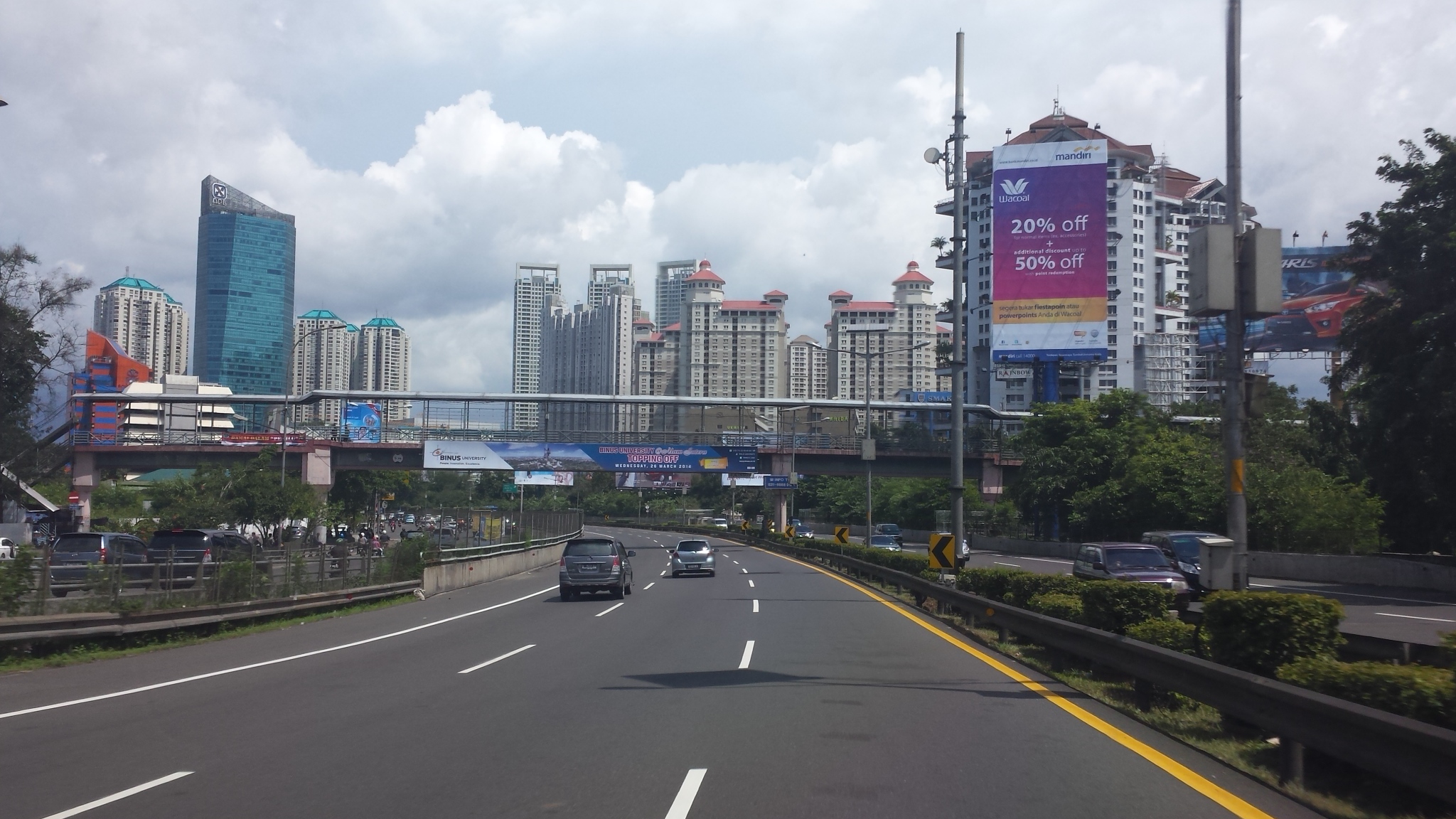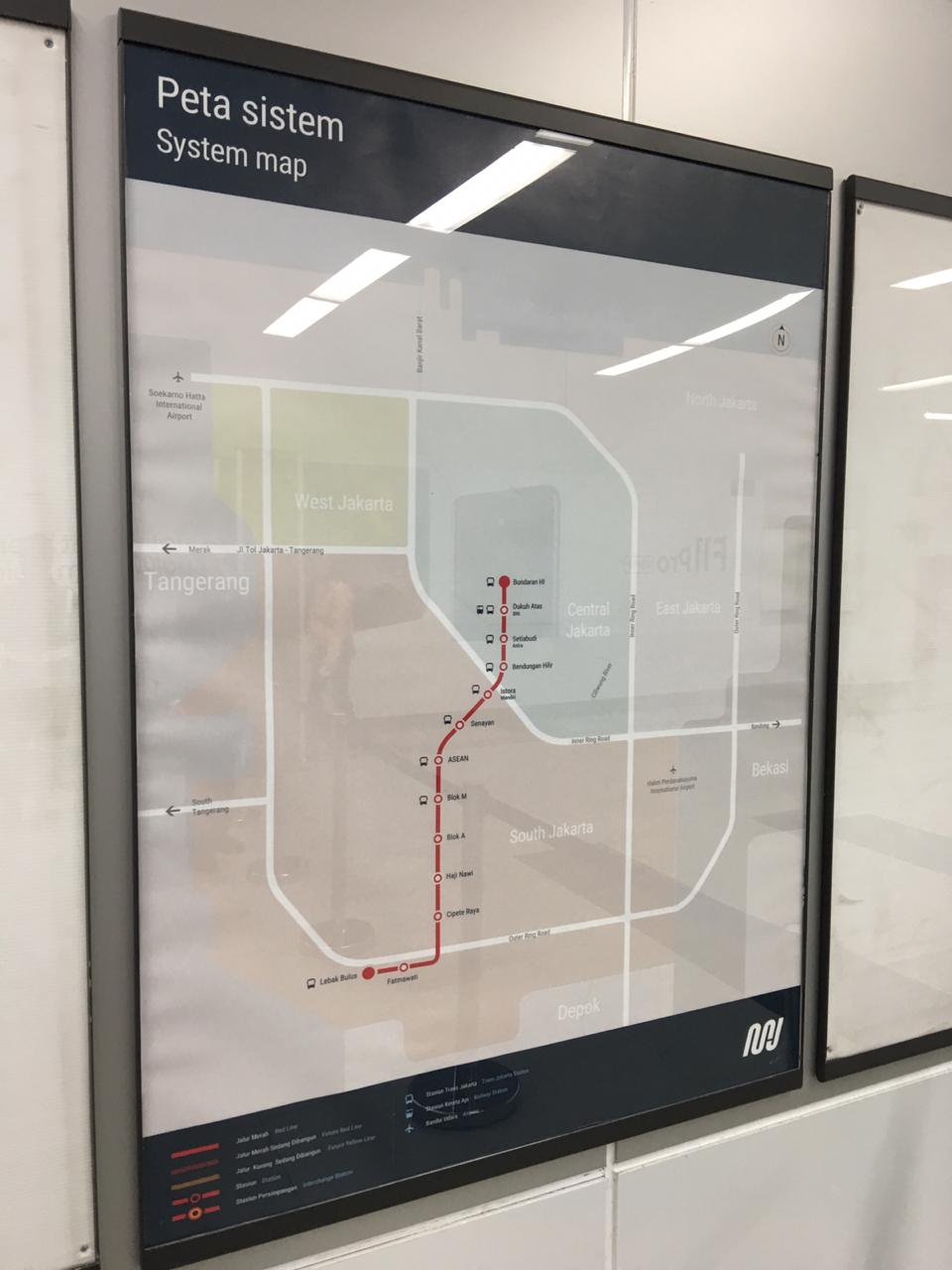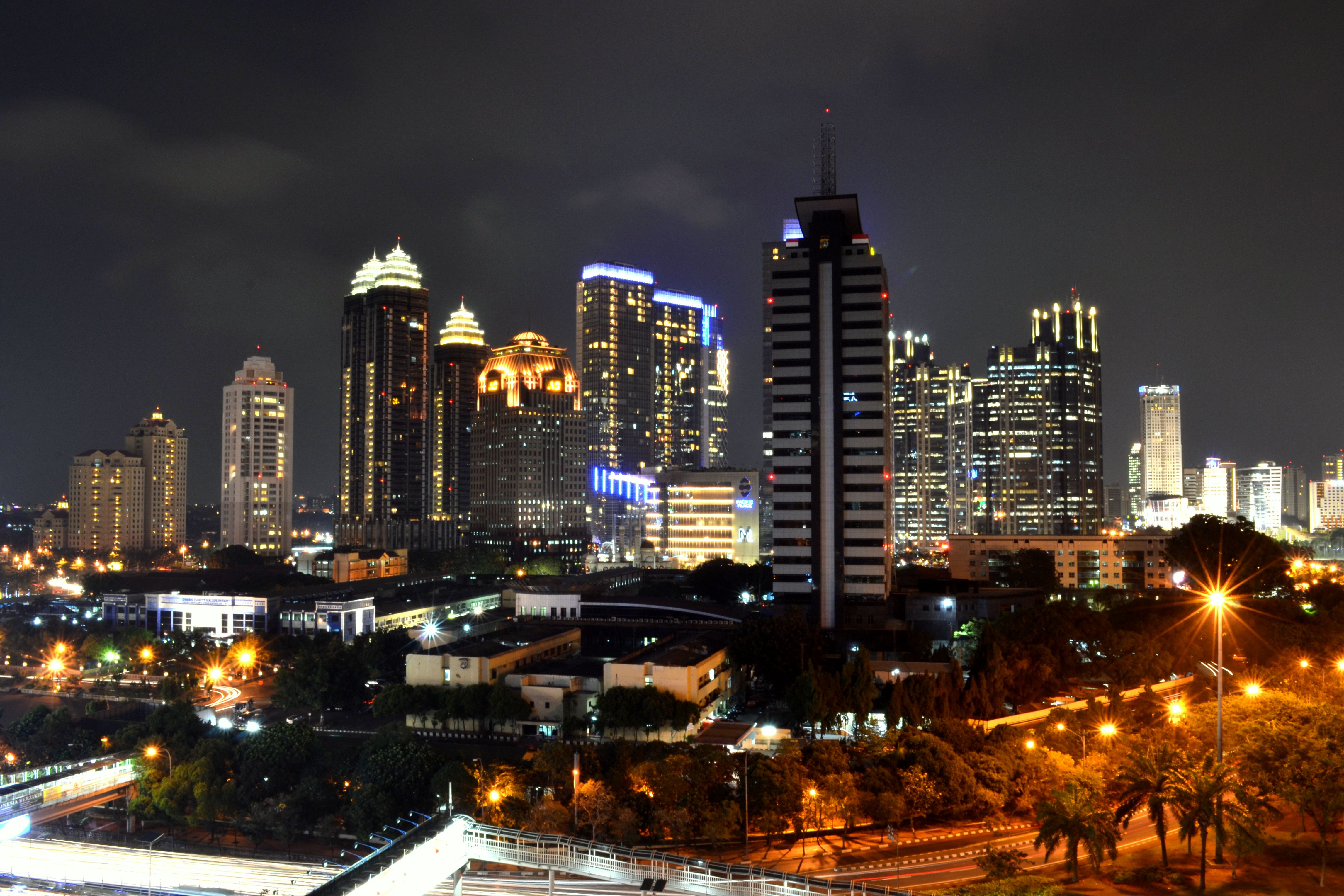|
Transport In Jakarta
As a metropolitan area of about 30 million people, Jakarta has a variety of transport systems. Jakarta was awarded 2021 global Sustainable Transport Award (STA) for integrated public transportation system. The city prioritized development of road networks, which were mostly designed to accommodate private vehicles. A notable feature of Jakarta's present road system is the toll road network. Composed of an inner and outer ring road and five toll roads radiating outwards, the network provides inner as well as outer city connections. An 'odd-even' policy limits road use to cars with either odd or even-numbered registration plates on a particular day as a transitional measure to alleviate traffic congestion until the future introduction of electronic road pricing. There are many bus terminals in the city, from where buses operate on numerous routes to connect neighborhoods within the city limit, to other areas of Greater Jakarta area and to cities across the island of Java. The bigge ... [...More Info...] [...Related Items...] OR: [Wikipedia] [Google] [Baidu] |
TransJakarta
TransJakarta (stylised as transjakarta, often erroneously called Busway) is a bus rapid transit (BRT) system in Jakarta, Indonesia. The first BRT system in Southeast Asia, it commenced operations on 15 January 2004 to provide a fast public transport system to help reduce rush hour traffic. The system is considered as the first revolutionary public transit mode in the capital city of Indonesia. The buses run in dedicated lanes (busways), and ticket prices are subsidised by the regional government. TransJakarta has the world's longest BRT system (251.2 km in length), which operates about 4,300 buses. As of February 2020, it serves an average of 1.006 million passengers daily. TransJakarta system is operated by municipally-owned company PT Transportasi Jakarta. However, most of its fleet is operated by various companies aside of the company itself. History and development TransJakarta was built to provide a fast, comfortable, and affordable mass transportation system. To ... [...More Info...] [...Related Items...] OR: [Wikipedia] [Google] [Baidu] |
Jakarta Outer Ring Road
The Jakarta Outer Ring Road ( id, Jalan Tol Lingkar Luar Jakarta, abbreviated JORR) is a tolled ring road circling Jakarta, Indonesia. It is divided into 7 sections, totalling up to . The JORR is managed by four toll road companies: Jakarta Lingkar Baratsatu, Marga Lingkar Jakarta, Hutama Karya and . Sections Fee Route See also * Jakarta Outer Ring Road 2 *Jakarta Inner Ring Road * Jakarta Elevated Toll Road * Transport in Indonesia Indonesia's transport system has been shaped over time by the economic resource base of an archipelago with thousands of islands, and the distribution of its more than 200 million people concentrated mainly on a single island, Java. All modes ... External linksPT Jasa Marga website References {{Toll Roads in Indonesia, state=expanded[...More Info...] [...Related Items...] OR: [Wikipedia] [Google] [Baidu] |
Greater Jakarta LRT
The Greater Jakarta LRT or Jabodebek LRT is a light rail system currently under construction in Jakarta, the capital city of Indonesia, as well as the adjacent areas of West Java and Banten, both within the Jakarta Metropolitan area. It is being implemented by the central government. To be directly operated by Kereta Api Indonesia (KAI) (rather than by its subsidiary KAI Commuter), the system is planned to connect the Jakarta city center with suburbs in Greater Jakarta such as Bogor, Depok and Bekasi, hence its acronym "Jabodebek". Operation was initially targeted to begin in 2019. However, the line has been hampered by numerous delays. It is now targeted to be operational by June 2023. Background The Jakarta light rail transit project is aimed to tackle Jakarta's high road traffic congestion. The northern section of the LRT project partly replaces the Jakarta Monorail project which has been cancelled. The monorail project in Jakarta was planned since the early 2000s. Co ... [...More Info...] [...Related Items...] OR: [Wikipedia] [Google] [Baidu] |
KRL Commuterline
KRL Commuterline, or commonly known as Commuterline, is a commuter rail system for Greater Jakarta in Indonesia. It was previously known as KRL Jabodetabek. It is operated by PT KAI Commuter Indonesia (KAI Commuter/KCI), a subsidiary of the Indonesian national railway company PT Kereta Api Indonesia (KAI). The rail system uses rolling stock of rapid transit standard and operates at high frequency with a minimum headway. In 2019, the average number of KRL users per day reaches average of 1.04 million, with the record of the highest number of users served in a day being 1,154,080. "KRL" itself stands for "Kereta Rel Listrik" (literally "electric rail train" or "electric railcar"), a term for an electric multiple unit train. History Colonial era In 1917, a plan to introduce electrified railway in Batavia was made by Dutch colonial railway company Staatsspoorwegen. A railway between Tanjung Priok to ''Meester Cornelis'' (Jatinegara) was the first line to be electrified. The ... [...More Info...] [...Related Items...] OR: [Wikipedia] [Google] [Baidu] |
Jakarta MRT
The Jakarta Mass Rapid Transit ( id, Moda Raya Terpadu ''Jakarta'') or Jakarta MRT (, stylized as ''mrt jakarta'') is a rapid transit system in Jakarta, the capital city of Indonesia. The system is operated by PT Mass Rapid Transit Jakarta (Perseroda), a municipally owned ''perseroan terbatas'' of the city of Jakarta. Phase 1 of the project ( Lebak Bulus to Bundaran HI) was officially opened on 24 March 2019. Background Jakarta is the capital city of Indonesia, harbouring 10 million inhabitants, one-third of the population of Greater Jakarta. It is estimated that over four million residents of the surrounding Greater Jakarta area commute to and from the city each working day. Transport issues have increasingly begun to attract political attention and it has been foreseen that without a major transportation breakthrough, the city will have complete traffic gridlock by 2020. As of 2010, public transportation in Jakarta served only 56% of commuter trips. This figure urgently ne ... [...More Info...] [...Related Items...] OR: [Wikipedia] [Google] [Baidu] |
Jakarta LRT
The Jakarta Light Rail Transit (Jakarta LRT) ( id, Lintas Rel Terpadu Jakarta, lit. "Jakarta Integrated Rail Line") is one of the light rail systems in Jakarta, the capital city of Indonesia. It is being implemented by the Jakarta provincial government. The first phase of the LRT, from to , began commercial operations on 1 December 2019. Jakarta LRT is operated by PT LRT Jakarta, a subsidiary of municipally-owned property and infrastructure company PT Jakarta Propertindo (Jakpro). History Background The proposal for the LRT system in Jakarta emerged when the Jakarta Monorail construction project stalled. The stalled construction of the monorail was caused by the Governor of Jakarta, Basuki Tjahaja Purnama, who did not approve of the construction of the monorail depot above the Setiabudi Reservoir. This depot plan was rejected so that the 2013 Jakarta Flood incident caused by the collapse of the Latuharhari Embankment would not happen again. Eventually, the monorail proj ... [...More Info...] [...Related Items...] OR: [Wikipedia] [Google] [Baidu] |
Greater Jakarta Area
The Jakarta metropolitan area or Greater Jakarta, known locally as Jabodetabek (an acronym of Jakarta– Bogor–Depok–Tangerang–Bekasi), and sometimes extended to Jabodetabekjur (with the acronym extended to include part of Cianjur Regency), or Jabodetabekpunjur (further extended to include Puncak and the Cipanas district), is the most populous metropolitan area in Indonesia. It includes the national capital (Jakarta Special Capital Region, as the core city) as well as five satellite cities and three complete regencies. The original term "Jabotabek" dated from the late 1970s and was revised to "Jabodetabek" in 1999 when "De" (for "Depok") was inserted into the name following its formation. The term "Jabodetabekjur" or "Jabodetabekpunjur" was legalised on the Presidential Regulation Number 54 of 2008, although the name Jabodetabek is more commonly used. The area comprises Jakarta Special Capital Region and parts of West Java and Banten provinces, specifically the three ... [...More Info...] [...Related Items...] OR: [Wikipedia] [Google] [Baidu] |
Surabaya
Surabaya ( jv, ꦱꦸꦫꦧꦪ or jv, ꦯꦹꦫꦨꦪ; ; ) is the capital city of the Indonesian province of East Java and the second-largest city in Indonesia, after Jakarta. Located on the northeastern border of Java island, on the Madura Strait, it is one of the earliest port cities in Southeast Asia. According to the National Development Planning Agency, Surabaya is one of the four main central cities of Indonesia, alongside Jakarta, Medan, and Makassar. The city has a population of 2.87 million within its city limits at the 2020 census and 9.5 million in the extended Surabaya metropolitan area, making it the second-largest metropolitan area in Indonesia. The city was settled in the 10th century by the Kingdom of Janggala, one of the two Javanese kingdoms that was formed in 1045 when Airlangga abdicated his throne in favor of his two sons. In the late 15th and 16th centuries, Surabaya grew to be a duchy, a major political and military power as w ... [...More Info...] [...Related Items...] OR: [Wikipedia] [Google] [Baidu] |
Bandung
Bandung ( su, ᮘᮔ᮪ᮓᮥᮀ, Bandung, ; ) is the capital city of the Indonesian province of West Java. It has a population of 2,452,943 within its city limits according to the official estimates as at mid 2021, making it the fourth most populous city in Indonesia. Greater Bandung (Bandung Basin Metropolitan Area/BBMA) is the country's third-largest metropolitan area, with nearly nine million inhabitants. Located above sea level, the highest point in the North area with an altitude of 1,050 meters and the lowest in the South is 675 meters above sea level, approximately southeast of Jakarta, Bandung has cooler year-round temperatures than most other Indonesian cities. The city lies on a river basin surrounded by volcanic mountains that provides a natural defence system, which was the primary reason for the Dutch East Indies government's plan to move the capital from Batavia (modern-day Jakarta) to Bandung. The Dutch first established tea plantations around the mo ... [...More Info...] [...Related Items...] OR: [Wikipedia] [Google] [Baidu] |
High-speed Rail In Indonesia
Indonesia's first high-speed rail (HSR) project is expected to connect the country's largest cities of Jakarta and Bandung, the 3rd largest city and capital of West Java, covering a distance approaching . , the prime contractor, PT. Kereta Cepat Indonesia China, has stated that the construction of the Jakarta-Bandung phase has reached 90% completion and is expected reach 100% by the end of 2022. Plans and studies have been in the works for high-speed rail (HSR) in Indonesia for many years. It was seriously contemplated in 2008, with detailed plans set forth in 2015. The new plan to start Jakarta-Bandung HSR construction was announced by the Indonesian government in July 2015, after the Chinese President and other world leaders visited the Bandung Conference. The cost for the line is expected to be $8 billion USD. The EMU KCIC400AF Fuxing trainset and the KCIC400AF CIT 22 01 trainset arrived in Indonesia mid 2022 and will be tested in November 2022 during the G20 Indonesia ev ... [...More Info...] [...Related Items...] OR: [Wikipedia] [Google] [Baidu] |
Pulo Gebang Bus Terminal
Pulo Gebang Bus Terminal is a type-A bus terminal at Cakung, in East Jakarta, Indonesia, which is arguably the largest of its kind in Southeast Asia. The terminal was opened on 28 December 2016. Buses to and from Central & East Java usually use this terminal. Pulo Gebang bus terminal has a land area of about 12.6 hectares with 4 building blocks. Each of the passenger terminal has four-story building with elevators, escalators, automatic doors, AC waiting rooms and surveillance cameras or CCTV. The terminal has dedicated area for food court, retail shop, mosque, car parking, health centre etc. It is connected with other terminals of Jakarta by TransJakarta feeder bus. Some of the feeder routes connecting the terminal operates 24 hours. Facilities Facilities available in Pulo Gebang bus terminal are: * Mezzanine floor Counters for intercity buses, Transjakarta bus stop, announcement room and other facilities. * 1st floor Parking lots for intercity buses, cars, motorcycle and ta ... [...More Info...] [...Related Items...] OR: [Wikipedia] [Google] [Baidu] |





